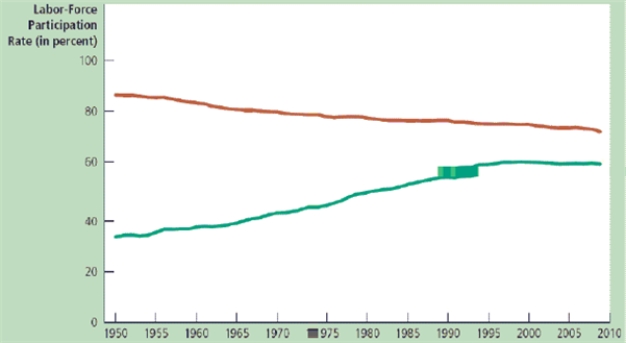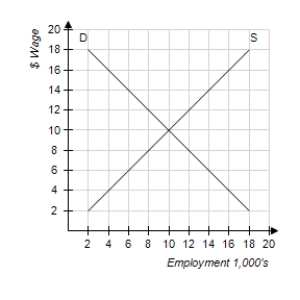A) 11
B) 10
C) 9
D) 8
F) A) and D)
Correct Answer

verified
Correct Answer
verified
Multiple Choice
Matilda just graduated from college. In order to devote all her efforts to college, she didn't hold a job. She is going to tour around the country on her motorcycle for a month before she starts looking for work. Other things the same, the unemployment rate
A) increases, and the labor-force participation rate decreases.
B) and the labor-force participation rate both increase.
C) increases, and the labor-force participation rate is unaffected.
D) and the labor-force participation rate are both unaffected.
F) C) and D)
Correct Answer

verified
Correct Answer
verified
Multiple Choice
Unions
A) do not affect the natural rate of unemployment.
B) lower the wages of unionized workers.
C) raise the profits of unionized firms.
D) lower the wages of workers in industries without unions.
F) All of the above
Correct Answer

verified
Correct Answer
verified
True/False
The unemployment rate equals the percentage of the labor force that is unemployed.
B) False
Correct Answer

verified
Correct Answer
verified
Multiple Choice
Unemployment insurance
A) reduces search effort which raises unemployment.
B) reduces search effort which lowers unemployment.
C) increases search effort which raises unemployment.
D) increases search effort which decreases unemployment.
F) A) and C)
Correct Answer

verified
Correct Answer
verified
Multiple Choice
When a minimum-wage law forces the wage to remain above the equilibrium level, the result is
A) both a shortage of labor and a shortage of jobs.
B) a shortage of labor and a surplus of jobs.
C) a surplus of labor and a shortage of jobs.
D) both surplus of labor and a surplus of jobs.
F) B) and C)
Correct Answer

verified
Correct Answer
verified
Multiple Choice
Which of the following is correct?
A) In unionized industries, wages are below the level that would prevail in competitive markets.
B) The introduction of a union in an industry reduces the quantity of labor demanded in that industry, causes some workers in that industry to be unemployed, and reduces wages in the rest of the economy.
C) There is a strong consensus among economists that unions are bad for the U.S. economy.
D) All of the above are correct.
F) A) and C)
Correct Answer

verified
Correct Answer
verified
Multiple Choice
Table 28-2
Labor Data for Aridia  -Refer to Table 28-2. The unemployment rate of Aridia in 2011 was
-Refer to Table 28-2. The unemployment rate of Aridia in 2011 was
A) 20%.
B) 31.6%.
C) 46.2%.
D) 63.3%.
F) A) and C)
Correct Answer

verified
Correct Answer
verified
True/False
According to the theory of efficiency wages, firms operate more efficiently if wages are above the equilibrium level.
B) False
Correct Answer

verified
True
Correct Answer
verified
Multiple Choice
Which of the following is not an explanation for the existence of unemployment in the long run?
A) it takes time for workers to search for the jobs that are best suited for them
B) minimum-wage laws
C) unions
D) the business cycle
F) C) and D)
Correct Answer

verified
Correct Answer
verified
Multiple Choice
If the natural rate of unemployment is 5.2 percent and the actual rate of unemployment is 5.7 percent, then by definition there is
A) cyclical unemployment amounting to 0.5 percent of the labor force.
B) frictional unemployment amounting to 0.5 percent of the labor force.
C) structural unemployment amounting to 0.5 percent of the labor force.
D) search unemployment amounting to 0.5 percent of the labor force.
F) A) and D)
Correct Answer

verified
Correct Answer
verified
True/False
More than one-third of the unemployed are recent entrants into the labor force.
B) False
Correct Answer

verified
True
Correct Answer
verified
True/False
Table 28-11
2015 Labor Data for Tajnia  -Refer to Table 28-11. The labor-force participation rate of Tajnia in 2015 is about 40.8 percent.
-Refer to Table 28-11. The labor-force participation rate of Tajnia in 2015 is about 40.8 percent.
B) False
Correct Answer

verified
Correct Answer
verified
True/False
Table 28-11
2015 Labor Data for Tajnia  -Refer to Table 28-11. The unemployment rate of Tajnia in 2015 is about 18.4 percent.
-Refer to Table 28-11. The unemployment rate of Tajnia in 2015 is about 18.4 percent.
B) False
Correct Answer

verified
Correct Answer
verified
Multiple Choice
Figure 28-2  -Refer to Figure 28-2. What do the two lines in the figure measure?
-Refer to Figure 28-2. What do the two lines in the figure measure?
A) The top line is the labor force participation rate, and the bottom line is the unemployment rate.
B) The top line is the labor force participation rates of the college-educated population, and bottom line is the labor force participation rates of the high-school-educated population.
C) The top line is the foreign labor force participation rate, and the bottom line is the domestic labor force participation rate.
D) The top line is the labor force participation rates of men, and the bottom line is the labor force participation rates of women.
F) All of the above
Correct Answer

verified
Correct Answer
verified
True/False
Within the U.S. population, blacks of prime working age (ages 25-54) have higher rates of unemployment than whites of prime working age (ages 25-54), regardless of gender.
B) False
Correct Answer

verified
Correct Answer
verified
Multiple Choice
Figure 28-4
 -Refer to Figure 28-4. If 12,000 workers are unemployed, then the minimum wage must be
-Refer to Figure 28-4. If 12,000 workers are unemployed, then the minimum wage must be
A) $4.
B) $6.
C) $14
D) $16.
F) A) and C)
Correct Answer

verified
D
Correct Answer
verified
Multiple Choice
Minimum-wage laws
A) create unemployment.
B) do not apply in states with right-to-work laws.
C) affect highly-educated workers more than high school dropouts.
D) cause labor shortages, which further raise wages above equilibrium.
F) C) and D)
Correct Answer

verified
Correct Answer
verified
True/False
Like any cartel, a union is a group of sellers acting together in the hope of exerting their joint market power.
B) False
Correct Answer

verified
Correct Answer
verified
Multiple Choice
Suppose that efficiency wages become more common in the economy. Imposing efficiency wages
A) increases the quantity demanded and decreases the quantity supplied of labor.
B) decreases the quantity demanded and increases the quantity supplied of labor.
C) decreases the quantity demanded and decreases the quantity supplied of labor.
D) increases the quantity demanded and increases the quantity supplied of labor.
F) None of the above
Correct Answer

verified
Correct Answer
verified
Showing 1 - 20 of 701
Related Exams